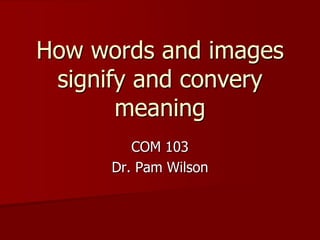
How words and images signify
- 1. How words and images signify and convery meaning COM 103 Dr. Pam Wilson
- 2. How do we communicate? Spoken language Non-verbal communication: Facial expressions Voice tone Gestures and body language Written communication Still images (photos, art) Moving images
- 4. Another model (adding interference, or “noise”)
- 5. Interference hinders communication process Communicator’s self-interference—lack of clear expression Channel interference—causes distortion Environmental interference—distractions in receiver’s surroundings Receiver interference—when the receiver (listener, reader, watcher) obstructs process through selective attention, exposure or perception
- 6. How does mass communication (media) change this model? Differences in time and space between sender and receivers Introduces technologies into the process Interpersonal often becomes one-to-many Limited range of CHANNELS
- 7. Interpersonal channels include simultaneous: Spoken language Facial expressions Tones of voice, non-linguistic utterances, energy in voice (e.g. excitement, dread, fear) Gestures and body language Possibly also written language (writing on blackboard, power point)
- 8. Media communication Limits that multi-channel experience (removes ability to see and hear and interpret gestures, etc.) Media communication process is not simultaneous (sending and receiving separated in time and space)—so feedback is delayed or non-existent e.g., broadcast communication, film, newspapers, magazines, web pages
- 9. Semiotics: study of how signs (words, images, gestures) signify meaning Meanings are ENCODED and DECODED Interpretation varied from receiver to receiver, but we are trained to “read” codes by our culture Analysis of visual systems of representation as well as language and sounds
- 10. Questions for Semiotics How do people communicate with each other? How does meaning (thoughts, feelings, attitudes, beliefs, visions, ideas) get encoded into messages? That is, how does the communicator (the “sender”) “package” those ideas, thoughts and feelings into a message that is communicated using various channels?
- 11. How do these messages get physically transferred from person to person? How do these messages get mentally “transferred” from the mind of one person to the mind(s) of other person(s)? How does a person on the receiving end “unpackage” (decode) the thoughts, feelings, attitudes, beliefs, visions, ideas? After “unpackaging” them, now does that person make sense of them or assign meaning to them? (interpretation)
- 12. If there are opportunities for response, feedback and interaction, how then do the participants in the communication exchange choose to interact in order to negotiate those meanings and act upon them?
- 13. Semiotics American philosopher & logician Charles Sanders Peirce (1839-1914) Founded “semiotics” as the scientific study of signs and sign processes– semiosis was the process of creating meaning
- 14. Peirce In 1907 he defined semiosis as "action, or influence, which is, or involves, a cooperation of three subjects, such as a sign, its object, and its interpretant.“
- 15. Peirce’s semiotics Sign= a signifier or symbol Three kinds of sign: icon, index, symbol Object =physical thing that a sign stands for Interpretant=concept of the meaning in the mind of the person doing the interpreting
- 17. Saussure’s semiologie Swiss linguist, Ferdinand de Saussure (1857-1913) Course in General Linguistics, his lectures published in 1915 after his death by two of his students Dyadic (two-part) model for how we use signs to signify meaning
- 18. process of significationin a sign system or code sign = signifier + signified signified is a concept (Peirce’s interpretant); referent is the object in reality (Peirce’s object) Signs are usually arbitrary
- 19. Sign or code SYSTEMS Depth beneath the surface: underneath the surface are hidden generative mechanisms (rules, formulas, etc.) that are organized and patterned GRAMMAR is the deep system for language But there are systems for non-linguistic codes as well—part of each culture Culture is a signifying system like language
- 20. Roland Barthes (1915-1980) French cultural theorist analysis of images as signs that are loaded with meaning, both denotative and connotative Especially pertinent to study visual culture: art, photography, advertising, popular culture and media
- 21. TWO LEVELS OF MEANING (Roland Barthes) Denotative: literal, descriptive meaning, providing documentary evidence of objective circumstances Connotative: culturally specific meanings that rely on the cultural and historical context of the image and its viewer’s lived, felt knowledge
- 22. Barthes’ famous example –Paris Match cover
- 23. Barthes and the image Signifier= the image 1st level signification: denotation (African boy in uniform saluting) 2nd level signification: connotation or myth Young African colonial subjects of France proudly and happily serve in the French military—an ideological statement
- 24. Barthes’ concepts Myth = cultural values and beliefs that are expressed at the level of connotation the hidden set of rules and conventions through which meanings are made to seem universal and natural (rather than culturally or historically specific)
- 25. Semiotics and media vocabulary based on analogies with language and reading: a TV documentary, a radio play, a Madonna song, a poster at a bus stop are all texts. users of these texts are referred to as readers the vocabulary of film the grammar of TV documentaries, etc.
- 26. For the following pictures, if the image is the signifier… What is the signified (concept)? What is the referent (real corresponding object)? What does the image denote (first-level signification)? What does the image connote (second level signification)?
- 27. Images have different purposes http://justpaste.it/2p8 (Advertising images) Images from photojournalism
- 28. Nick Ut,Vietnam Napalm 1972Associated Press
- 29. Jeff Widener, APTiananmen Square, BeijingJune 5, 1989
- 30. Charles Porter, IV Oklahoma City BombingApril 19, 1995
- 31. Dorothea LangeMigrant Mother;Nipomo, California1936
